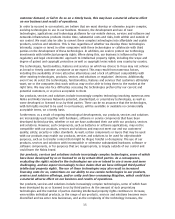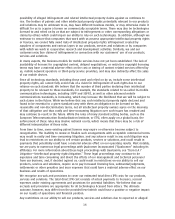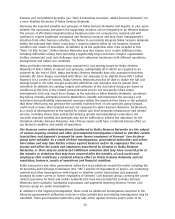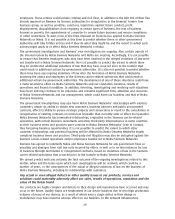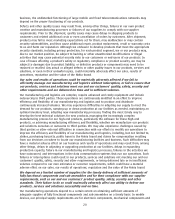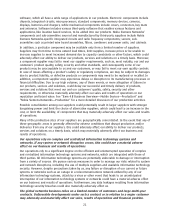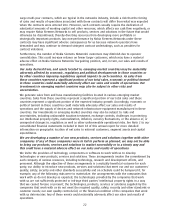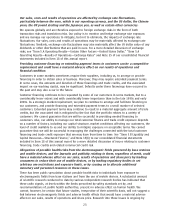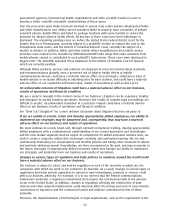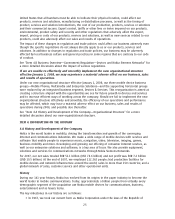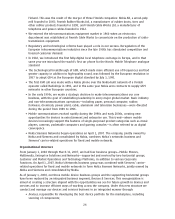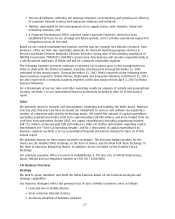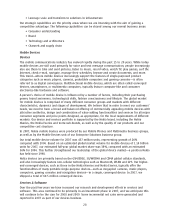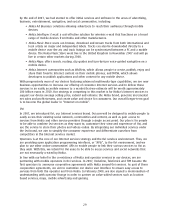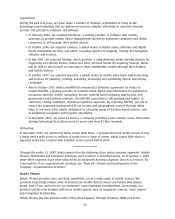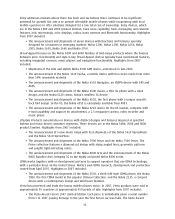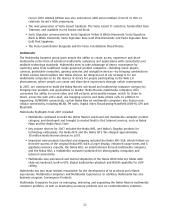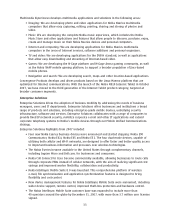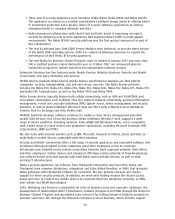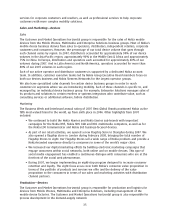Nokia 2007 Annual Report Download - page 26
Download and view the complete annual report
Please find page 26 of the 2007 Nokia annual report below. You can navigate through the pages in the report by either clicking on the pages listed below, or by using the keyword search tool below to find specific information within the annual report.United States that all handsets must be able to indicate their physical location, could affect our
products, services and solutions, manufacturing or distribution processes, as well as the timing of
product, services and solution introductions, the cost of our production, products, services or solutions
and their commercial success. Export control, tariffs or other fees or levies imposed on our products,
environmental, product safety and security and other regulations that adversely affect the export,
import, pricing or costs of our products, services and solutions, as well as new services related to our
products, could also adversely affect our sales and results of operations.
The impact of these changes in regulation and trade policies could affect our business adversely even
though the specific regulations do not always directly apply to us or our products, services and
solutions. In addition to changes in regulation and trade policies, our business may be adversely
affected by local business culture and general practices in some regions that are contrary to our code
of conduct.
See “Item 4.B Business Overview—Government Regulation—Devices and Nokia Siemens Networks” for
a more detailed discussion about the impact of various regulations.
If we are unable to effectively and smoothly implement the new organizational structure
effective January 1, 2008, we may experience a material adverse effect on our business, sales
and results of operations.
Under our new organizational structure effective January 1, 2008, our three mobile device business
groups—Mobile Phones, Multimedia and Enterprise Solutions—and the supporting horizontal groups
were replaced by an integrated business segment, Devices & Services. This reorganization is aimed at
creating a structure aligned with the opportunities we see for future growth in devices and services
and to increase efficient ways of working across the company. Should we fail to implement the new
organizational structure effectively and smoothly, the efficiency of our operations and performance
may be affected, which may have a material adverse effect on our business, sales and results of
operations during 2008, and possibly also thereafter.
See “Item 4.A History and Development of the Company—Organizational Structure” for a more
detailed discussion about our new organizational structure.
ITEM 4. INFORMATION ON THE COMPANY
4.A History and Development of the Company
Nokia is the world leader in mobility, driving the transformation and growth of the converging
Internet and communications industries. We make a wide range of mobile devices with services and
software that enable people to experience music, navigation, video, television, imaging, games,
business mobility and more. Developing and growing our offering of consumer Internet services, as
well as our enterprise solutions and software, is a key area of focus. We also provide equipment,
solutions and services for communications networks through Nokia Siemens Networks.
For 2007, our net sales totaled EUR 51.1 billion (USD 74.6 billion) and net profit was EUR 7.2 billion
(USD 10.5 billion). At the end of 2007, we employed 112 262 people; had production facilities for
mobile devices and network infrastructure around the world; sales in more than 150 countries; and a
global network of sales, customer service and other operational units.
History
During our 141 year history, Nokia has evolved from its origins in the paper industry to become the
world leader in mobile communications. Today, approximately a billion people from virtually every
demographic segment of the population use Nokia mobile devices for communications, business,
entertainment and as luxury items.
The key milestones in our history are as follows:
• In 1967, we took our current form as Nokia Corporation under the laws of the Republic of
25


